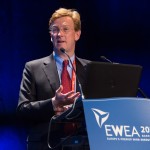Water used for EU power production equivalent to annual consumption of Germany
Nuclear, coal and gas plants in Europe use 4.5 billion m³ of water a year, equivalent to that of 82 million EU citizens – the same as the population of Germany – new research shows. Energy production represents 44% of the EU’s total water use: more than any other activity.
Yet wind energy, which uses no water, avoids the use of 1.2 billion m³ of water per year , representing savings of €2.4 billion says the report released today by the European Wind Energy Association (EWEA) at its annual event in Barcelona.
“Water equivalent to over three Olympic size swimming pools is consumed every minute of every day of the year to cool Europe’s nuclear, coal and gas plants”, pointed out Ivan Pineda of EWEA. “Increasing our use of wind energy will help preserve this precious resource far more effectively than any ban on watering the garden– while saving us money”.
Heads of state and government meeting on 20-21 March to discuss a 2030 climate and energy policy should take this research into account: boosting wind and renewable energy via an ambitious and binding renewable energy target for 2030 will have major benefits for the environment, as well as promoting green growth and jobs in a leading European industry.
Read the report: www.ewea.org/publications/reports/
More information: www.ewea.org/annual2014
El agua utilizada para la producción de energía en la UE es equivalente al consumo anual en Alemania
Las centrales nucleares y las plantas de carbón y gas en Europa utilizan 4.500 millones de m³ de agua al año, equivalente al consumo de 82 millones de ciudadanos de la UE, la población de Alemania, tal y como muestra un estudio reciente. La producción de energía representa el 44 % del consumo total de agua en la UE, más de cualquier otra actividad.
Sin embargo, la energía eólica, que no utiliza agua, evita el uso de 1.200 millones de m³ de agua al año, lo que representa un ahorro de 2.400 millones de euros, según el informe publicado hoy por la Asociación Europea de la Energía Eólica (EWEA) en su evento anual en Barcelona.
“Un volumen de agua equivalente a más de tres piscinas olímpicas se consume cada minuto de cada día del año para enfriar las centrales nucleares y las plantas de carbón y gas europeas», señaló Angeliki Koulouri de EWEA. «Aumentar el uso de la energía eólica ayudará a preservar este valioso recurso de forma mucho más eficaz que cualquier prohibición de regar el jardín, al mismo tiempo que nos permitirá ahorrar dinero.”
Los jefes de Estado y de Gobierno que se reúnan los días 20-21 de marzo para debatir sobre una política climática y energética de cara a 2030 deben tener en cuenta esta investigación: impulsar la energía eólica y las renovables a través de un objetivo de energía renovable ambicioso y vinculante para 2030 tendrá importantes beneficios para el medio ambiente e impulsará el crecimiento verde y el empleo en una industria líder a nivel europeo.
El informe: www.ewea.org/publications/reports/
Más información: www.ewea.org/annual2014.









